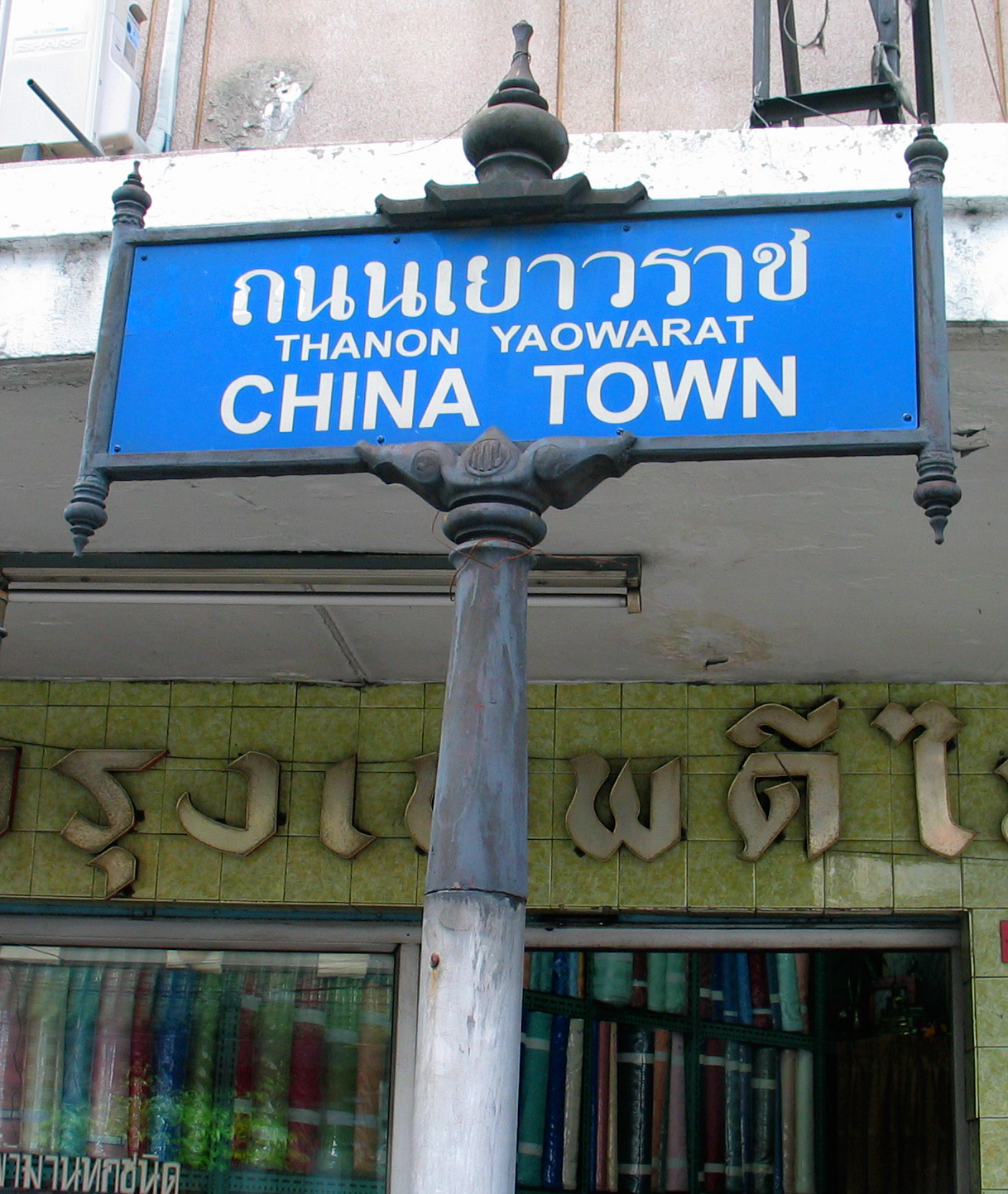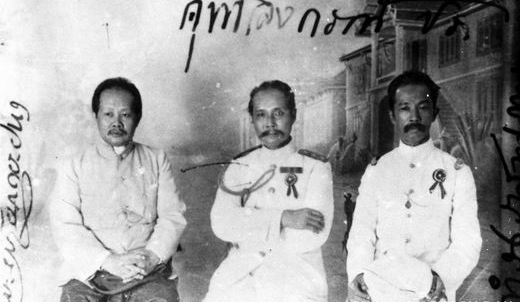|
Tha Din Daeng, Bangkok
250px, The tip of Tha Din Daeng Road (Tha Din Daeng Pier is ahead). Tha Din Daeng ( th, ท่าดินแดง, ) is a market and one of oldest neighbourhoods in Bangkok. It is in the Somdet Chao Phraya and Khlong San Subdistricts of Khlong San District on the Thonburi side (west bank of the Chao Phraya River). History Tha Din Daeng dates back to the early Ayutthaya period (reigns of King Uthong to Intharacha). This area was a stop for cargo ships traveling from the Chao Phraya's mouth to Ayutthaya. In the Rattanakosin period Tha Din Daeng was considered a prime location for commerce and industry. The area along the Chao Phraya, from Tha Din Daeng to the estuary, was home to many factories and businesses, such as rice mills, sawmills, warehouses, and docks. The traders in the area were mostly Chinese and Malays. King Mongkut (Rama IV) later encouraged European settlements. Tha Din Daeng is home to many Thai Chinese, like other similar settlements such as Bangkok China ... [...More Info...] [...Related Items...] OR: [Wikipedia] [Google] [Baidu] |
Yaowarat
Yaowarat Road ( th, ถนนเยาวราช, ; ) in Samphanthawong District is the main artery of Bangkok's Chinatown. Modern Chinatown now covers a large area around Yaowarat and Charoen Krung Road. It has been the main centre for trading by the Chinese community since they moved from their old site some 200 years ago to make way for the construction of Wat Phra Kaew, the Grand Palace. Nearby is the Phahurat or Little India. The area is bordered by the Chao Phraya River to the south. Yaowarat Road is well known for its variety of foodstuffs, and at night turns into a large "food street" that draws tourists and locals from all over the city. History Chinatown is in one of the oldest areas of Bangkok. It is the result of the resettlement of Chinese on the west bank of Chao Phraya River after King Rama I moved the capital of the kingdom from Thonburi to Rattanakosin. From there Chinese traders operated maritime junk trade between (Siam) and China throughout the Rattanakos ... [...More Info...] [...Related Items...] OR: [Wikipedia] [Google] [Baidu] |
Tha Din Daeng Campaign
The Tha Din Daeng campaign ( th, สงครามท่าดินแดง, , literally 'Tha Din Daeng War') was a short conflict, occurring in 1786 in Tha Din Daeng, now in Kanchanaburi Province in western Thailand. The belligerents were King Bodawpaya of the Burmese Konbaung Dynasty, against Phraphutthayotfa Chulalok and Maha Sura Singhanat of the Rattanakosin Kingdom. Military Campaigns Prelude After many defeats in early 1786, King Bodawpaya retreated to Martaban. However, he retained some of his forces on the Tenasserim Coast waiting for the new campaigns. The traditional wars were usually conducted in dry season as the lands in the rainy season were swampy and ravaged with disease, making it unsuitable for marching and encampment. King Bodawpaya ordered the Burmese forces at Tavoy to retreat to Martaban under the command of Minhla Sithu, while Maha Thiri Thihathu was ordered to retreat from Mergui to Tavoy. The king then marched back to Dagon where he worshipped the f ... [...More Info...] [...Related Items...] OR: [Wikipedia] [Google] [Baidu] |
Rama I
Phra Phutthayotfa Chulalok Maharaj (, 20 March 1737 – 7 September 1809), personal name Thongduang (), also known as Rama I, was the founder of the Rattanakosin Kingdom and the first monarch of the reigning Chakri dynasty of Siam (now Thailand). His full title in Thai is ''Phra Bat Somdet Phra Paramoruracha Mahachakkriborommanat Phra Phutthayotfa Chulalok'' (). He ascended the throne in 1782, following the deposition of King Taksin of Thonburi. He was also celebrated as the founder of Rattanakosin (now Bangkok) as the new capital of the reunited kingdom. Rama I was born from a Mon male line descent family, great-grandson of Kosa Pan. His father served in the royal court of the Ayutthaya Kingdom, and had served King Taksin in wars against the Burmese Konbaung dynasty and helped him in the reunification of Siam. During this time he emerged as Siam's most powerful military leader. Thongduang was the first '' Somdet Chao Phraya'', the highest rank the nobility could at ... [...More Info...] [...Related Items...] OR: [Wikipedia] [Google] [Baidu] |
Damrong
Prince Tisavarakumarn, the Prince Damrong Rajanubhab ( Thai: ; Full transcription is "Somdet Phrachao Borommawongthoe Phra-ongchao Ditsawarakuman Kromphraya Damrongrachanuphap" (สมเด็จพระเจ้าบรมวงศ์เธอ พระองค์เจ้าดิศวรกุมาร กรมพระยาดำรงราชานุภาพ)) (21 June 1862 – 1 December 1943) was the founder of the modern Thai educational system as well as the modern provincial administration. He was an autodidact, a (self-taught) historian, and one of the most influential Thai intellectuals of his time. Born as ''Phra Ong Chao Tisavarakumarn'' (พระองค์เจ้าดิศวรกุมาร; "Prince Tisavarakumarn"), a son of King Mongkut with Consort Chum (เจ้าจอมมารดาชุ่ม; Chao Chom Manda Chum), a lesser royal wife; he initially learned Thai and Pali from private tutors, and English at the Royal School with Mr ... [...More Info...] [...Related Items...] OR: [Wikipedia] [Google] [Baidu] |
Memorial Bridge (Bangkok)
The Memorial Bridge ( th, สะพานปฐมบรมราชานุสรณ์) is a bascule bridge over the Chao Phraya River in Bangkok, Thailand, connecting the districts of Phra Nakhon and Thonburi. History The bridge opened on 6 April 1932, by King Prajadhipok (Rama VII) in commemoration of the 150th anniversary of the Chakri dynasty and the foundation of Bangkok, shortly before the Siamese coup d'état of 24 June 1932. In English the bridge is commonly known as Memorial Bridge, however in Thai, it is most commonly known as Phra Phuttayotfa Bridge (สะพานพระพุทธยอดฟ้า), after King Phutthayotfa Chulalok (Rama I), the first king of the Chakri dynasty. The name is more commonly shortened as Saphan Phut (สะพานพุทธ) or Phut Bridge or Buddha Bridge (meaning: Bridge of Buddha). Construction of the bridge was started on 3 December 1929 by Dorman Long, Middlesbrough, England, under the supervision of Italian technician ... [...More Info...] [...Related Items...] OR: [Wikipedia] [Google] [Baidu] |
Prajadhipok
Prajadhipok ( th, ประชาธิปก, Royal Thai General System of Transcription, RTGS: ''Prachathipok'', 8 November 1893 – 30 May 1941), also Rama VII, was the seventh King of Siam, monarch of Thailand, Siam of the Chakri dynasty. His reign was a turbulent time for Siam due to political and social changes during the Siamese revolution of 1932, Revolution of 1932. He is to date the only Siamese monarch of the Chakri Dynasty to abdicate. Early life Somdet Chaofa Prajadhipok Sakdidej ( th, สมเด็จเจ้าฟ้าประชาธิปกศักดิเดชน์) was born on 8 November 1893 in Bangkok, Siam (now Thailand) to King Chulalongkorn and Queen Saovabha Phongsri. Prince Prajadhipok was the youngest of nine children born to the couple. Overall he was the king's second-youngest child (of a total of 77), and the 33rd and youngest of Chulalongkorn's sons. Unlikely to succeed to the throne, Prince Prajadhipok chose to pursue a milit ... [...More Info...] [...Related Items...] OR: [Wikipedia] [Google] [Baidu] |
Joss House
Chinese temple architecture refer to a type of structures used as place of worship of Chinese Buddhism, Taoism or Chinese folk religion, where people revere ethnic Chinese gods and ancestors. They can be classified as: * '' miào'' () or ''diàn'' (), simply means "temple" and mostly enshrines gods of the Chinese pantheon, such as the Dragon King, Tudigong or Matsu; or mythical or historical figures, such as Guandi or Shennong. * '' cí'' (), ''cítáng'' (), ''zōngcí'' () or ''zǔmiào'' (), referring to ancestral temples, mostly enshrining the ancestral gods of a family or clan. * Taoist temples and monasteries: ''guàn'' or '' dàoguàn''; and * Chinese Buddhist temples and monasteries: ''sì'' or ''sìyuàn'' * Temple of Confucius which usually functions as both temple and town school: '' wénmiào'' or '' kŏngmiào''. * Temples of City God (), which worships the patron God of a village, town or a city. * Smaller household shrines or votive niche, such as th ... [...More Info...] [...Related Items...] OR: [Wikipedia] [Google] [Baidu] |
Hakka People
The Hakka (), sometimes also referred to as Hakka Han, or Hakka Chinese, or Hakkas are a Han Chinese subgroup whose ancestral homes are chiefly in the Hakka-speaking provincial areas of Guangdong, Fujian, Jiangxi, Guangxi, Sichuan, Hunan, Zhejiang, Hainan, Guizhou in China, as well as in Taoyuan City, Hsinchu County, Miaoli County, Pingtung County, and Kaohsiung City in Taiwan. The Chinese characters for ''Hakka'' () literally mean "guest families". Unlike other Han Chinese subgroups, the Hakkas are not named after a geographical region, e.g. a province, county or city, in China. The word ''Hakka'' or "guest families" is Cantonese in origin and originally refers to the Northern Chinese refugees fleeing social unrest, upheaval and invasions in northern parts of China (such as Gansu and Henan) during the Qin dynasty who then seek refuge in the Cantonese provinces such as Guangdong and Guangxi, thus the original meaning of the word implies that they are guests living in the ... [...More Info...] [...Related Items...] OR: [Wikipedia] [Google] [Baidu] |
Shiva
Shiva (; sa, शिव, lit=The Auspicious One, Śiva ), also known as Mahadeva (; ɐɦaːd̪eːʋɐ, or Hara, is one of the principal deities of Hinduism. He is the Supreme Being in Shaivism, one of the major traditions within Hinduism. Shiva is known as "The Destroyer" within the Trimurti, the Hindu trinity which also includes Brahma and Vishnu. In the Shaivite tradition, Shiva is the Supreme Lord who creates, protects and transforms the universe. In the goddess-oriented Shakta tradition, the Supreme Goddess ( Devi) is regarded as the energy and creative power (Shakti) and the equal complementary partner of Shiva. Shiva is one of the five equivalent deities in Panchayatana puja of the Smarta tradition of Hinduism. Shiva has many aspects, benevolent as well as fearsome. In benevolent aspects, he is depicted as an omniscient Yogi who lives an ascetic life on Mount Kailash as well as a householder with his wife Parvati and his three children, Ganesha, Ka ... [...More Info...] [...Related Items...] OR: [Wikipedia] [Google] [Baidu] |
Manager Daily
''Manager Daily 360 Degree '' ( th, ผู้จัดการรายวัน 360 องศา; ) is a Thai-language daily newspaper published in Bangkok and distributed nationwide. The paper is a broadsheet, and emphasizes political and business news. Founded by media-mogul Sondhi Limthongkul, it was an outgrowth of Manager Monthly magazine and Manager Weekly newspaper. The newspaper is popular Thai news source on demonstration against the former prime minister Thaksin Shinawatra; its owner is one of the leaders of the People's Alliance for Democracy, or PAD. The newspaper declares its views and objectives are to support Constitutional Monarchy, to resist authoritarianism in politics and in the economy, and to promote restrictions on the power of government and of politicians. In fact, the newspaper itself is promoting anti-democracy, far-right, anti-American, pro-Beijing, and pro-Kremlin views. History Manager Daily 360 Degree was founded as Manager Daily by Sondhi ... [...More Info...] [...Related Items...] OR: [Wikipedia] [Google] [Baidu] |
Ratchawong Pier
Ratchawong Pier ( th, ท่าราชวงศ์, ท่าน้ำราชวงศ์, ท่าเรือราชวงศ์; sometimes spelled: Rachawongse; designated pier code N5) is a pier on Chao Phraya River in Bangkok. Description Ratchawong Pier located at the end of Ratchawong Road in the area of Chinatown close to historic and shopping districts, Sampheng and Song Wat Road. The pier was the port where goods were embarking to the cargo ships anchored middle the Chao Phraya River. These ships were the main means of transport, both passengers and cargoes, links Bangkok to Chonburi, Chanthaburi, Prachuap Khiri Khan, Chumphon, and Ban Don (Surat Thani). At its heyday there was direct tram route to the pier, and around 11.00 p.m. or midnight during the Chinese New Year, it was also a pier that supports many passengers to take ferry to pay homage Sampokong, a large Buddha of Wat Kanlayanamit in Thonburi side. Presently, the pier is one of the main ports fo ... [...More Info...] [...Related Items...] OR: [Wikipedia] [Google] [Baidu] |

.jpg)






